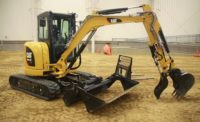Looking to simplify its product lines and streamline production, Caterpillar has introduced a trio of 20-ton-class excavators aimed at a broad range of applications. The company also expanded its offerings in the consumer market with a Cat-branded utility vehicle.
“This is the first major redesign of this product in 25 years,” said Cat CEO Jim Umpleby, who cited the new excavator line as part of a broader strategy when addressing journalists at a Nov. 15 briefing. “I think our team is taking the right direction to help our customers succeed.”
All three models are built on the same platform with common parts and maintenance, a sign that Cat is trying to reduce the wide array of parts and servicing its dealers require for some of the company’s more fragmented product lines.
But the excavators are more than just a rationalization of manufacturing. All three machines feature electrohydraulic control valves, and electronically controlled pumps and engines. “We put a new digital heart in these machines,” says Zack Kauk, vice president for Cat’s excavator division. “We’re standardizing across our entire excavator product line.” While these features have been available on some of Cat’s excavators in the past, Kauk says they will be standard on all excavators going forward. According to Kauk, the electronic “digital heart” delivers a 45% increase in efficiency, a 25% reduction in fuel cost and a 15% lower maintenance cost compared to Cat’s previous line of excavators.
The 320 GC is aimed at rental customers and smaller contractors that are more focused on smaller jobs or don’t operate their excavators at full production. The 320 excavator is the standard model, boasting 2D machine controls as a standard. The heavy-duty 323 excavator is a production machine, with a reinforced boom and improved performance. Both the 320 and 323 are wired to accept full 3D controls and 2D slope controls as options. “This is possible because of the digital heart,” says Kauk.
The 320 and 323 also sport sensors on the boom and bucket that allow for electronic fencing of the excavators’ movements. An operator can program in a working ceiling or floor to reduce the chance of accidents when working near power lines or buried utilities, and rotational swing can be limited for jobsites near existing structures or active roadways. Features like this are nothing new, but making them standard on the some models within a size class is the key difference, according to Brian Stelbrink, Cat market professional for global construction and infrastructure.
“Going forward, we’ll offer multiple value propositions within size classes as we launch the 36-ton class next year, followed by the 30-ton class over the next two years,” he told ENR. The three-model lineup—with a less-featured model for contractors paid by the job, a standard model, and a high-production model for contractors paid by the ton—is an approach that will go beyond excavators.
One thing missing from the excavator line is an XE model, the highly efficient, high-production model featured in earlier excavator lineups. Stelbrink says it’s not an accident. “We’ve already incorporated all of that [technology] into our products, so there’s no need for a separate model.”
Caterpillar also recently launched a Cat-branded utility vehicle aimed at both the construction and recreational markets. The utility vehicle is available with a gas or diesel engine, with the diesel model targeted toward construction sites.
The utility vehicle lacks a power take-off, and does not have any option for powered attachments. Caterpillar has not said whether later models will include these features, but the utility vehicle is initially being targeted as a crossover machine for the contractor and consumer markets, much like the line of home generators that Cat introduced last year.







Post a comment to this article
Report Abusive Comment